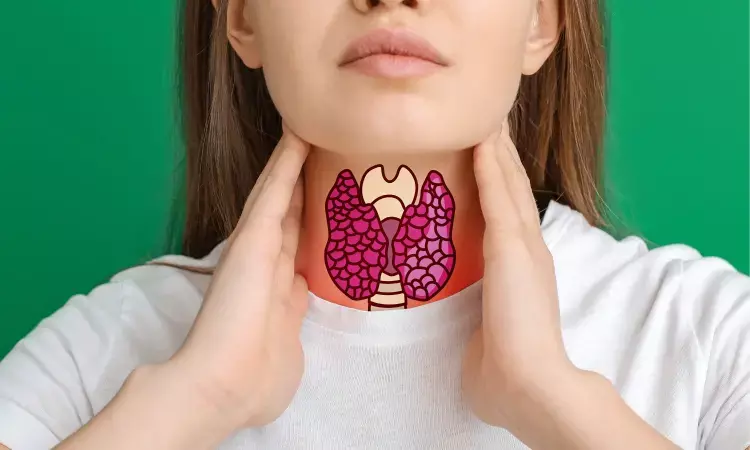- Home
- Medical news & Guidelines
- Anesthesiology
- Cardiology and CTVS
- Critical Care
- Dentistry
- Dermatology
- Diabetes and Endocrinology
- ENT
- Gastroenterology
- Medicine
- Nephrology
- Neurology
- Obstretics-Gynaecology
- Oncology
- Ophthalmology
- Orthopaedics
- Pediatrics-Neonatology
- Psychiatry
- Pulmonology
- Radiology
- Surgery
- Urology
- Laboratory Medicine
- Diet
- Nursing
- Paramedical
- Physiotherapy
- Health news
- Fact Check
- Bone Health Fact Check
- Brain Health Fact Check
- Cancer Related Fact Check
- Child Care Fact Check
- Dental and oral health fact check
- Diabetes and metabolic health fact check
- Diet and Nutrition Fact Check
- Eye and ENT Care Fact Check
- Fitness fact check
- Gut health fact check
- Heart health fact check
- Kidney health fact check
- Medical education fact check
- Men's health fact check
- Respiratory fact check
- Skin and hair care fact check
- Vaccine and Immunization fact check
- Women's health fact check
- AYUSH
- State News
- Andaman and Nicobar Islands
- Andhra Pradesh
- Arunachal Pradesh
- Assam
- Bihar
- Chandigarh
- Chattisgarh
- Dadra and Nagar Haveli
- Daman and Diu
- Delhi
- Goa
- Gujarat
- Haryana
- Himachal Pradesh
- Jammu & Kashmir
- Jharkhand
- Karnataka
- Kerala
- Ladakh
- Lakshadweep
- Madhya Pradesh
- Maharashtra
- Manipur
- Meghalaya
- Mizoram
- Nagaland
- Odisha
- Puducherry
- Punjab
- Rajasthan
- Sikkim
- Tamil Nadu
- Telangana
- Tripura
- Uttar Pradesh
- Uttrakhand
- West Bengal
- Medical Education
- Industry
Chronic hypoparathyroidism during pregnancy tied to preterm birth, blood transfusions and congenital anomalies

In the general population, Hyperparathyroidism is the most common endocrine disorder after diabetes and thyroid disorders. The condition is rare among women of childbearing age, with a reported prevalence of 0.05%. It is the most common cause of hypercalcemia during Pregnancy and a preventable cause of maternal and neonatal morbidity and mortality.
Researchers reported increased rates of preterm birth, blood transfusions and congenital anomalies in chronic hypoparathyroidism. The condition is a risk factor for Pregnancy and neonatal complications, according to a recent study,
This study, Pregnancy, Delivery and Neonatal Outcomes among Women with Hypoparathyroidism population-based study, is led by Alyssa Hochberg.
The Data regarding pregnancy complications associated with maternal chronic hypoparathyroidism are inconclusive.
In the present study, researchers aimed to compare Pregnancy, delivery and neonatal outcomes in patients with chronic hypoparathyroidism to those without chronic hypoparathyroidism in their retrospective population-based study utilising data HCUP-NIS from the Healthcare Cost and Utilization Project Nationwide Inpatient Sample database over 11 years (2004 to 2014)inclusively. Obstetric and neonatal outcomes were measured.
Key results of the study are:
- Two hundred four pregnant women had chronic hypoparathyroidism, and 9,096,584 pregnancies were without chronic hypoparathyroidism.
- Comparisons were made between patients in the hypoparathyroidism group and those without hypoparathyroidism; following adjustments for age, insurance plan type, obesity, chronic hypertension, thyroid disease, pregestational diabetes mellitus, and previous caesarean section, researchers reported increased preterm birth rate, <37 weeks and blood transfusion recorded as 19.1% vs. 7.2% 4.9% vs. 1.0%.
- The aOR was 2.49 and 4.07, respectively.
- There were higher rates of congenital anomalies in Neonates to mothers with chronic hypoparathyroidism recorded as 4.4% vs 0.4% and aOR of 6.50 with comparable rates of small-for-gestational-age neonates and intrauterine foetal death.
They noted, “This is the largest study of chronic hypoparathyroidism in pregnancy to date.”
The team found elevated risk in rates of preterm birth, blood transfusions and congenital anomalies in chronic hypoparathyroidism, thereby implicating the importance of identifying chronic hypoparathyroidism as a risk factor for Pregnancy and neonatal complications.
They highlighted that there needs to be more studies to find out if maintaining calcium in the target range mitigates these risks.
Further reading:
BDS, MDS in Periodontics and Implantology
Dr. Aditi Yadav is a BDS, MDS in Periodontics and Implantology. She has a clinical experience of 5 years as a laser dental surgeon. She also has a Diploma in clinical research and pharmacovigilance and is a Certified data scientist. She is currently working as a content developer in e-health services. Dr. Yadav has a keen interest in Medical Journalism and is actively involved in Medical Research writing.
Dr Kamal Kant Kohli-MBBS, DTCD- a chest specialist with more than 30 years of practice and a flair for writing clinical articles, Dr Kamal Kant Kohli joined Medical Dialogues as a Chief Editor of Medical News. Besides writing articles, as an editor, he proofreads and verifies all the medical content published on Medical Dialogues including those coming from journals, studies,medical conferences,guidelines etc. Email: drkohli@medicaldialogues.in. Contact no. 011-43720751


